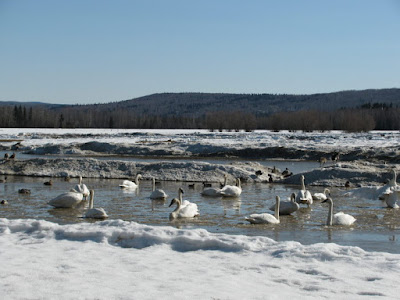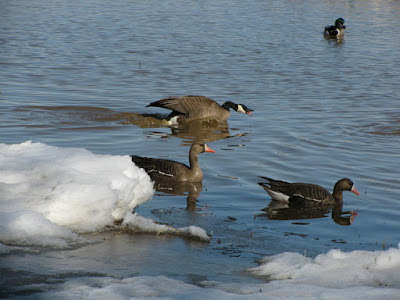Cygnus buccinator (Trumpeter Swan, or Naki Hakuchou in Japanese).
They are now in Creamer's Field.
There are lots of swans, geese and ducks now.
It was pretty cold outside on that day, so we had to take tea breaks in our rig twice while we were taking pictures of the birds.
There are many other people coming to visit the field in order to see and enjoy the arrival of the birds. I was amazed at the size of the swans. It seems bigger than the ones we can see in Japan, which are Cygnus cygnus (Whooper Swan, or Oo Hakuchou in Japanese) and Cygnus columbianus (Tundra Swan, or Ko Hakuchou in Japanese).
Most of the geese we could see there on that day were Branta canadensis (Canada goose),
but we found some Anser albifrons (Greater white-fronted goose, or Ma-gan in Japanese), too.
For ducks, most of them were Anas platyrhynchos (Mallard, or Magamo in Japanese), but we also found some Anas acuta (Northern pintail, or Onaga-gamo in Japanese) and Anas americana (American wigeon, or America Hidori in Japanese). We saw the former in Japan before, but we saw the latter probably just once in Tokyo, because almost all of the wigeons you can see in Japan are Anas penelope (Eurasian wigeon).
I wonder when Sandhill cranes will be back to this field.
店のキッチンマネージャーから、クリーマーズ・フィールドにハクチョウが来たよ、という情報を得て、早速、見に行ってきました。先週の頭に通りがっかった時は何もいなかったのに、ほんの数日でこんなにもかわるのかというほど、水鳥たちがたくさんいました。
ぱっと見で、いちばん多いのはカナダガン。ハクチョウも多かったです。ハクチョウの中でも最大種のナキハクチョウとのことで、翼を広げた姿はとても大きくて圧巻でした。
カナダガンに混じって、マガンも数羽、カモの仲間は、マガモが多くて、オナガガモ、アメリカヒドリが混じっていました。
Swans and geese and ducks are now back to Creamer's Field.
There were many lovely couples of swans.
In the morning, the surface of water was still frozen
and they were walking on the thin ice.
Amazingly huge!
Cygnus buccinator (Trumpeter Swan, or Naki Hakuchou in Japanese)
and Branta canadensis (Canada goose) behind.
A flock of Branta canadensis (Canada goose)
was marching on the ice.
Many Branta canadensis (Canada goose) were
resting on the snow.
How many kinds of waterfowls can you see?
The immature swans were gray.
Anas platyrhynchos (Mallard, or Magamo in Japanese).
How could they hold their heavy body with only one leg?
Branta canadensis (Canada goose).
Branta canadensis (Canada goose).
Anas acuta (Northern pintail, or Onaga-gamo in Japanese).
We saw them in Tokyo, too.
Anas americana (American wigeon, or America Hidori in Japanese).
We maybe saw one just once before in Tokyo.
Most of the wigeons you can see in Tokyo are Eurasian wigeons.
Anas americana (American wigeon, or America Hidori in Japanese)
in center.
Anas americana (American wigeon, or America Hidori in Japanese).
Anser albifrons (Greater white-fronted goose, or Ma-gan in Japanese).
Anser albifrons (Greater white-fronted goose, or Ma-gan in Japanese).
The ones with Orange-White beak.
Anser albifrons (Greater white-fronted goose, or Ma-gan in Japanese)
and Anas platyrhynchos (Mallard, or Magamo in Japanese).
We found a bug in our house...
It was a kind of Ichineumon wasp.
長い産卵管を持ったヒメバチの一種が家の中に迷い込んでいました。







































No comments:
Post a Comment